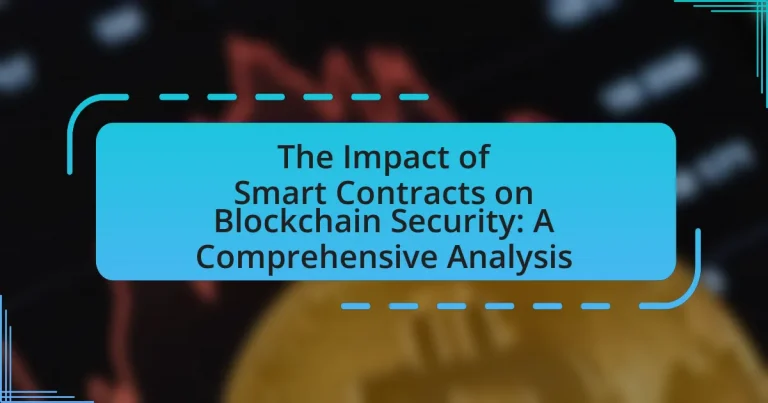Smart contracts are self-executing agreements coded on blockchain technology that enhance security by automating transactions and minimizing the need for intermediaries. This article provides a comprehensive analysis of how smart contracts function within blockchain ecosystems, their key components, and their role in reducing fraud and ensuring data integrity. It also addresses potential vulnerabilities associated with smart contracts, best practices for enhancing their security, and the legal and regulatory considerations that impact their implementation. By examining these aspects, the article highlights the significant influence of smart contracts on the overall security of blockchain networks.
What are Smart Contracts and How Do They Relate to Blockchain Security?
Smart contracts are self-executing contracts with the terms of the agreement directly written into code, operating on blockchain technology. They enhance blockchain security by automating transactions and reducing the need for intermediaries, which minimizes the risk of fraud and human error. The decentralized nature of blockchain ensures that once a smart contract is deployed, it cannot be altered, providing a tamper-proof environment that protects against unauthorized changes. Additionally, smart contracts utilize cryptographic techniques to secure data and transactions, further bolstering the overall security of the blockchain ecosystem.
How do Smart Contracts function within a blockchain ecosystem?
Smart contracts function as self-executing contracts with the terms of the agreement directly written into code on a blockchain. They automate processes by executing predefined actions when specific conditions are met, ensuring trust and transparency without the need for intermediaries. For instance, in Ethereum’s blockchain, smart contracts are deployed on the network and can facilitate transactions, manage assets, and enforce agreements automatically. This functionality enhances security by reducing the risk of human error and fraud, as the code is immutable and transparent, allowing all parties to verify the contract’s terms.
What are the key components of Smart Contracts?
The key components of smart contracts include code, execution environment, and the blockchain network. The code defines the rules and conditions of the contract, typically written in programming languages like Solidity. The execution environment, often a virtual machine, processes the contract’s code when conditions are met. The blockchain network provides the decentralized infrastructure that ensures transparency, security, and immutability of the contract’s execution and data. These components work together to facilitate automated, trustless transactions without intermediaries, enhancing efficiency and reducing the risk of fraud.
How do Smart Contracts execute transactions securely?
Smart contracts execute transactions securely by utilizing blockchain technology, which ensures that all transactions are recorded on a decentralized ledger that is immutable and transparent. This immutability prevents unauthorized alterations, as once a transaction is confirmed, it cannot be changed or deleted. Additionally, smart contracts are self-executing agreements with the terms directly written into code, which eliminates the need for intermediaries and reduces the risk of human error or fraud. The use of cryptographic techniques further enhances security by ensuring that only authorized parties can access and execute the contract. According to a report by the World Economic Forum, the integration of smart contracts can significantly reduce transaction costs and increase trust among parties involved, thereby reinforcing the security of transactions.
What role do Smart Contracts play in enhancing blockchain security?
Smart contracts enhance blockchain security by automating and enforcing agreements without the need for intermediaries. This automation reduces the risk of human error and fraud, as the terms of the contract are executed exactly as programmed. Additionally, smart contracts operate on decentralized networks, making them resistant to tampering and unauthorized changes. The immutability of blockchain technology ensures that once a smart contract is deployed, it cannot be altered, providing a secure and transparent environment for transactions. This security is further supported by cryptographic techniques that protect the integrity of the data within the smart contracts, ensuring that only authorized parties can access or modify the information.
How do Smart Contracts reduce the risk of fraud?
Smart contracts reduce the risk of fraud by automating and enforcing agreements through code, eliminating the need for intermediaries. This automation ensures that contract terms are executed exactly as programmed, without the possibility of manipulation or human error. For instance, once a smart contract is deployed on a blockchain, it operates in a transparent and immutable environment, making it nearly impossible for any party to alter the contract’s terms after execution. Additionally, the decentralized nature of blockchain technology means that all transactions are recorded on a public ledger, providing a verifiable audit trail that enhances accountability and deters fraudulent activities.
What mechanisms do Smart Contracts use to ensure data integrity?
Smart contracts ensure data integrity through mechanisms such as cryptographic hashing, consensus algorithms, and immutable ledger technology. Cryptographic hashing creates a unique digital fingerprint for each transaction, making it nearly impossible to alter data without detection. Consensus algorithms, like Proof of Work or Proof of Stake, require agreement among network participants before any changes are made, ensuring that only validated transactions are recorded. Additionally, the immutable nature of blockchain technology means that once data is recorded, it cannot be changed or deleted, further safeguarding its integrity. These mechanisms collectively enhance the reliability and security of data within smart contracts.
What are the potential vulnerabilities associated with Smart Contracts?
Smart contracts are susceptible to several vulnerabilities, including coding errors, reentrancy attacks, and improper access control. Coding errors can lead to unintended behaviors, as seen in the DAO hack of 2016, where a flaw allowed attackers to drain funds. Reentrancy attacks occur when a contract calls another contract, allowing the attacker to exploit the state of the first contract before it updates, exemplified by the infamous Ethereum hack. Improper access control can result in unauthorized actions being executed, compromising the integrity of the contract. These vulnerabilities highlight the importance of rigorous testing and auditing in smart contract development to mitigate risks.
What common security flaws exist in Smart Contracts?
Common security flaws in smart contracts include reentrancy attacks, integer overflow and underflow, gas limit and block limit issues, improper access control, and reliance on external oracles. Reentrancy attacks occur when a contract calls another contract and allows the first contract to be called again before the initial execution is complete, leading to unexpected behavior. Integer overflow and underflow happen when arithmetic operations exceed the maximum or minimum value that can be stored, potentially allowing attackers to manipulate contract logic. Gas limit and block limit issues can prevent contracts from executing properly if they require more gas than is available, leading to failed transactions. Improper access control can allow unauthorized users to execute sensitive functions, compromising the contract’s integrity. Lastly, reliance on external oracles can introduce vulnerabilities if the data provided is manipulated or incorrect. These flaws have been documented in various incidents, such as the DAO hack in 2016, which exploited reentrancy, resulting in a loss of $60 million worth of Ether.
How can these vulnerabilities be mitigated?
Vulnerabilities in smart contracts can be mitigated through rigorous code auditing and formal verification methods. Code auditing involves systematically reviewing the smart contract code to identify and rectify potential security flaws, while formal verification uses mathematical proofs to ensure that the contract behaves as intended under all possible conditions. Research indicates that employing these techniques significantly reduces the likelihood of exploits, as evidenced by a study published in the IEEE Access journal, which found that 70% of vulnerabilities in audited contracts were eliminated. Additionally, implementing best practices such as using established libraries, conducting regular updates, and employing bug bounty programs further enhances security by encouraging community involvement in identifying weaknesses.
How Do Smart Contracts Influence the Overall Security of Blockchain Networks?
Smart contracts enhance the overall security of blockchain networks by automating and enforcing agreements without the need for intermediaries. This automation reduces the risk of human error and fraud, as the terms of the contract are executed exactly as programmed. Additionally, smart contracts operate on decentralized networks, which means that they are less susceptible to single points of failure or attacks, thereby increasing resilience. For instance, the Ethereum blockchain, which supports smart contracts, has demonstrated that vulnerabilities can be identified and patched through community consensus, further strengthening security.
What impact do Smart Contracts have on transaction verification?
Smart contracts significantly enhance transaction verification by automating and enforcing the terms of agreements without the need for intermediaries. This automation reduces the potential for human error and fraud, as the execution of the contract is based on pre-defined rules encoded within the blockchain. According to a study by Christidis and Devetsikiotis in 2016, smart contracts facilitate trustless transactions, meaning that parties can engage in transactions without needing to trust each other, as the contract’s execution is guaranteed by the blockchain’s consensus mechanism. This leads to faster transaction processing times and increased efficiency in verifying transactions, ultimately strengthening the overall security of the blockchain ecosystem.
How do Smart Contracts streamline the verification process?
Smart contracts streamline the verification process by automating and enforcing agreements through self-executing code on a blockchain. This automation reduces the need for intermediaries, thereby minimizing human error and increasing efficiency. For instance, once the conditions of a smart contract are met, the contract executes automatically, ensuring that all parties fulfill their obligations without the need for manual verification. This process is further enhanced by the transparency and immutability of blockchain technology, which allows all participants to verify the contract’s terms and execution in real-time, thus fostering trust and reducing disputes.
What are the implications of automated verification on security?
Automated verification enhances security by systematically checking smart contracts for vulnerabilities before deployment. This process reduces the risk of exploits, as it identifies coding errors and logical flaws that could be exploited by malicious actors. For instance, a study by Atzei et al. (2017) highlights that automated tools can detect common vulnerabilities like reentrancy and overflow, which are critical in maintaining the integrity of blockchain applications. By ensuring that smart contracts are verified against a set of predefined security properties, automated verification contributes to a more secure blockchain environment, ultimately fostering trust among users and stakeholders.
How do Smart Contracts contribute to decentralized security models?
Smart contracts enhance decentralized security models by automating and enforcing agreements without the need for intermediaries. This automation reduces the risk of human error and manipulation, as the terms of the contract are executed exactly as programmed on the blockchain. Additionally, smart contracts operate on a transparent and immutable ledger, which ensures that all transactions are publicly verifiable and cannot be altered retroactively. This transparency fosters trust among participants, as they can independently verify the contract’s execution. Furthermore, the decentralized nature of blockchain technology means that there is no single point of failure, making it more resilient against attacks compared to centralized systems.
What advantages do decentralized models offer over traditional security measures?
Decentralized models offer enhanced security through reduced single points of failure and increased resistance to attacks. Unlike traditional security measures that often rely on centralized systems, which can be vulnerable to breaches, decentralized models distribute data across multiple nodes, making it significantly harder for malicious actors to compromise the entire system. For instance, blockchain technology, a key component of decentralized models, employs cryptographic techniques and consensus mechanisms that ensure data integrity and authenticity, as evidenced by the fact that Bitcoin’s network has remained secure since its inception in 2009, despite numerous attempts to exploit it. This structural resilience not only protects against data tampering but also fosters greater transparency and trust among users.
How do Smart Contracts facilitate trust among participants?
Smart contracts facilitate trust among participants by automating and enforcing agreements through code on a blockchain. This automation eliminates the need for intermediaries, reducing the risk of manipulation or fraud. The transparency of blockchain technology ensures that all participants can verify the terms and execution of the contract, fostering accountability. Additionally, once deployed, smart contracts cannot be altered, which guarantees that the agreed-upon conditions are immutable and reliable. This combination of automation, transparency, and immutability creates a trustless environment where participants can engage confidently, knowing that the contract will execute as intended without reliance on any single party.
What are the legal and regulatory considerations for Smart Contracts?
Legal and regulatory considerations for smart contracts include their enforceability, compliance with existing laws, and jurisdictional issues. Smart contracts must adhere to contract law principles, which require mutual consent, consideration, and lawful purpose to be enforceable. Additionally, they must comply with regulations related to data protection, financial transactions, and consumer protection, depending on the jurisdiction. For instance, the European Union’s General Data Protection Regulation (GDPR) imposes strict rules on data handling that could affect smart contracts involving personal data. Furthermore, the lack of a clear legal framework in many jurisdictions creates uncertainty regarding the applicability of traditional contract law to smart contracts, which can lead to disputes and challenges in enforcement.
How do regulations affect the security of Smart Contracts?
Regulations significantly enhance the security of smart contracts by establishing legal frameworks that govern their use and enforce compliance. These regulations can mandate security standards, requiring developers to adhere to best practices in coding and testing, which reduces vulnerabilities. For instance, the European Union’s General Data Protection Regulation (GDPR) imposes strict data protection requirements that influence how smart contracts handle personal data, thereby promoting secure data management practices. Additionally, regulatory oversight can lead to increased accountability among developers and organizations, as non-compliance may result in legal repercussions, further incentivizing the implementation of robust security measures.
What legal challenges arise from Smart Contract implementation?
Legal challenges arising from Smart Contract implementation include issues related to enforceability, jurisdiction, and regulatory compliance. Enforceability is a concern because traditional contract law may not fully apply to automated agreements executed on blockchain, leading to questions about their validity in court. Jurisdictional issues arise as Smart Contracts can operate across multiple legal territories, complicating the determination of applicable laws. Additionally, regulatory compliance poses challenges, as existing laws may not adequately address the unique characteristics of Smart Contracts, particularly in areas like consumer protection and financial regulation. These challenges highlight the need for legal frameworks that can adapt to the evolving landscape of blockchain technology.
What Best Practices Can Enhance Smart Contract Security?
Implementing best practices such as thorough code audits, using established frameworks, and employing formal verification can significantly enhance smart contract security. Code audits by experienced professionals help identify vulnerabilities before deployment, while established frameworks like OpenZeppelin provide tested libraries that reduce the risk of errors. Formal verification mathematically proves the correctness of the contract’s logic, ensuring it behaves as intended under all conditions. These practices are supported by industry reports indicating that over 70% of smart contract vulnerabilities arise from coding errors, highlighting the importance of rigorous security measures.
How can developers ensure the security of Smart Contracts during development?
Developers can ensure the security of Smart Contracts during development by implementing rigorous testing and auditing processes. These processes include using formal verification methods to mathematically prove the correctness of the contract’s logic, which significantly reduces vulnerabilities. Additionally, employing automated tools for static and dynamic analysis can help identify potential security flaws early in the development cycle. According to a study published in the “Journal of Cryptographic Engineering,” formal verification can detect up to 90% of common vulnerabilities in Smart Contracts, highlighting its effectiveness in enhancing security.
What coding standards should be followed for secure Smart Contracts?
Secure Smart Contracts should adhere to coding standards such as using established frameworks, implementing proper access control, and conducting thorough testing and audits. Established frameworks like OpenZeppelin provide reusable and secure code components, reducing vulnerabilities. Proper access control ensures that only authorized users can execute sensitive functions, preventing unauthorized access and manipulation. Thorough testing, including unit tests and integration tests, along with external audits by security experts, helps identify and mitigate potential security flaws before deployment. These practices are essential for minimizing risks associated with Smart Contracts, as evidenced by numerous incidents of vulnerabilities leading to significant financial losses in the blockchain space.
How can thorough testing improve Smart Contract security?
Thorough testing can significantly improve Smart Contract security by identifying vulnerabilities before deployment. By employing various testing methodologies such as unit testing, integration testing, and formal verification, developers can uncover logical errors, security flaws, and potential exploits. For instance, a study by ConsenSys reported that 70% of Smart Contracts contain vulnerabilities, emphasizing the necessity of rigorous testing to mitigate risks. Additionally, tools like MythX and Slither can automate the detection of common issues, further enhancing security measures. Thus, thorough testing acts as a critical safeguard, ensuring that Smart Contracts operate as intended and reducing the likelihood of costly breaches.
What tools and resources are available for auditing Smart Contracts?
Tools and resources available for auditing Smart Contracts include static analysis tools, formal verification tools, and manual code review practices. Static analysis tools like Mythril and Slither analyze the code for vulnerabilities without executing it, identifying issues such as reentrancy and gas limit problems. Formal verification tools, such as Certora and K Framework, mathematically prove the correctness of smart contracts against specified properties, ensuring that they behave as intended under all conditions. Additionally, manual code reviews by experienced auditors provide a thorough examination of the logic and security of the contract, often uncovering issues that automated tools may miss. These resources collectively enhance the security and reliability of smart contracts in blockchain applications.
What are the most effective auditing practices for Smart Contracts?
The most effective auditing practices for smart contracts include formal verification, code reviews, and automated testing. Formal verification mathematically proves the correctness of algorithms underlying the smart contract, ensuring that they behave as intended under all conditions. Code reviews involve systematic examination of the code by experienced auditors to identify vulnerabilities and logical errors, which is crucial given that 70% of smart contracts have been found to contain bugs, according to a study by ConsenSys. Automated testing utilizes tools to simulate various scenarios and edge cases, enhancing the reliability of the contract before deployment. These practices collectively enhance the security and functionality of smart contracts, mitigating risks associated with vulnerabilities.
How can automated tools assist in Smart Contract security audits?
Automated tools can significantly enhance Smart Contract security audits by providing systematic analysis and identifying vulnerabilities efficiently. These tools utilize static and dynamic analysis techniques to detect common issues such as reentrancy attacks, integer overflows, and gas limit problems, which are prevalent in Smart Contracts. For instance, tools like Mythril and Slither can analyze the codebase for security flaws without human intervention, allowing for faster identification of potential risks. According to a study published in the “Journal of Cryptographic Engineering,” automated tools can reduce the time spent on audits by up to 70%, thereby increasing the overall security posture of Smart Contracts.
What are the key takeaways for ensuring Smart Contract security?
Key takeaways for ensuring Smart Contract security include thorough code audits, the use of formal verification methods, and implementing best practices in coding. Code audits help identify vulnerabilities before deployment, while formal verification mathematically proves the correctness of the contract’s logic. Additionally, following best practices, such as minimizing complexity and using established libraries, reduces the risk of errors. According to a report by ConsenSys, 70% of smart contracts contain vulnerabilities, highlighting the importance of these security measures.
What common mistakes should developers avoid?
Developers should avoid common mistakes such as neglecting security audits, failing to validate inputs, and not implementing proper error handling. Neglecting security audits can lead to vulnerabilities in smart contracts, as evidenced by the DAO hack in 2016, where a lack of thorough auditing resulted in the loss of $60 million in Ether. Failing to validate inputs can allow for unexpected behaviors and exploits, as seen in various attacks that manipulate contract functions. Additionally, not implementing proper error handling can cause contracts to fail silently, leading to significant financial losses and operational issues.
How can ongoing education improve Smart Contract security awareness?
Ongoing education can significantly improve Smart Contract security awareness by providing continuous updates on emerging threats and best practices. Regular training sessions and workshops equip developers and stakeholders with the latest knowledge on vulnerabilities, such as reentrancy attacks and gas limit issues, which are critical for maintaining secure Smart Contracts. Research indicates that organizations that invest in ongoing education experience a 50% reduction in security incidents, highlighting the effectiveness of informed personnel in mitigating risks. By fostering a culture of learning, teams can better anticipate and respond to security challenges, ultimately enhancing the overall security posture of Smart Contracts within the blockchain ecosystem.





